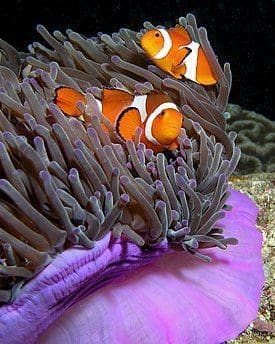
In the vast and diverse world of marine life, there are fascinating creatures that possess a truly remarkable ability – they can change their sex. These marine animals have evolved an extraordinary strategy to adapt to various environmental conditions and reproductive challenges. From fish to invertebrates, their unique ability to change sex plays a crucial role in shaping their populations and maintaining the balance of marine ecosystems.
In this article, we will explore some of these incredible species and delve into the mechanisms and significance of sex change in the underwater realm. Join us on this captivating journey into the lives of marine animals that challenge conventional notions of gender and reproduction.
Contents
Hermafroditismo in the Animal Kingdom.🐟
Hermafroditismo, also known as hermaphroditism, is a fascinating biological phenomenon observed in various species across the animal kingdom. This unique reproductive strategy challenges traditional notions of sexual dimorphism, where individuals typically belong to either male or female sexes. In hermaphroditic organisms, an individual possesses both male and female reproductive organs, allowing them to produce both eggs and sperm.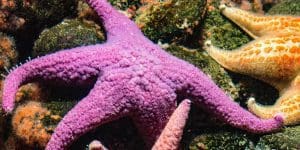
This intriguing characteristic presents a range of reproductive possibilities and is particularly prevalent in certain marine organisms. Let’s delve into the concept of hermaphroditism, exploring its significance and the occurrence of sex change in various marine species.
Definition and Explanation of Hermaphroditism:
Hermaphroditism refers to the condition in which an individual organism possesses both male and female reproductive organs. Unlike separate sexes in dioecious species, hermaphroditic organisms can self-fertilize, mate with other individuals of the same species, or even switch their sex during their lifetime. This phenomenon is a unique adaptation that has evolved in response to specific ecological, environmental, and reproductive challenges faced by these organisms.
Occurrence of Sex Change in Marine Animals:
Within the animal kingdom, hermaphroditism is particularly common among marine species. Numerous fish, mollusks, and other invertebrates exhibit the ability to change their sex throughout their lives. This remarkable feature allows them to optimize their reproductive success and adapt to the varying conditions of their aquatic habitats. Some marine animals start their lives as one sex and transition to the other as they age, while others can change sex repeatedly depending on environmental factors or social dynamics within their populations.
The ability to change sex provides these marine organisms with increased flexibility in finding mates and maximizing their reproductive output. It ensures the survival and growth of their populations by enhancing genetic diversity and overcoming the limitations imposed by a scarcity of available mates.
Reasons behind Sex Change in Marine Animals.🐟
The ability of certain marine animals to change their sex during their lifetime is a remarkable biological phenomenon that has intrigued scientists for years. This intriguing characteristic is not merely a random occurrence; it has deep-rooted evolutionary and adaptive significance. In this section, we will explore the reasons behind the sex change observed in various marine organisms, shedding light on the evolutionary advantages and adaptive benefits it provides for their survival and reproduction.
Evolutionary and Adaptive Reasons for Sex Change in Marine Animals: The evolution of sex change in marine animals can be attributed to several factors that enhance their reproductive success and survival in dynamic marine ecosystems. One key reason is the optimization of reproductive opportunities. By possessing both male and female reproductive organs, hermaphroditic marine animals increase their chances of successful reproduction. This ensures that they can mate with any suitable individual they encounter, maximizing their genetic contribution to future generations.
Advantages of Sex Change in Terms of Survival and Reproduction:
- Sequential Hermaphroditism: Some marine species exhibit sequential hermaphroditism, where individuals start their lives as one sex and later transition to the other. For example, many fish species are protogynous hermaphrodites, meaning they are born female and become males later in life. This strategy is advantageous in environments where large, dominant males monopolize access to females. By changing sex, smaller individuals can avoid competition for mates and increase their reproductive opportunities as males.
- Simultaneous Hermaphroditism: Other marine species, such as certain sea slugs and some reef fish, are simultaneous hermaphrodites, meaning they possess both male and female reproductive organs at the same time. This ensures that when they encounter another individual, both can function as both male and female during mating, increasing the chances of successful fertilization for both partners.
- Reproductive Assurance: Sex change in marine animals can also serve as a reproductive insurance policy. In environments with unpredictable or fluctuating population densities, being able to switch sex allows individuals to increase their chances of successfully reproducing, even when the availability of potential mates fluctuates.
Examples of Marine Animals that Change Sex.🐟
The underwater world is home to an astonishing array of marine animals that exhibit a unique and fascinating ability – the capacity to change their sex. This intriguing phenomenon, known as sequential hermaphroditism, is prevalent in various aquatic species, from fish to mollusks and other invertebrates. In this section, we will explore several captivating examples of marine organisms that are renowned for their remarkable capability to switch genders throughout their lives.
Clownfish (Amphiprioninae):
Clownfish, famously featured in the movie “Finding Nemo,” are protandrous hermaphrodites. They begin their lives as males, but when the dominant female of a group dies, the largest male undergoes a sex change to become the new breeding female. This sequential hermaphroditism ensures the continuity of the social structure within their anemone homes and maximizes reproductive success within the group.
Parrotfish (Scaridae):
Parrotfish are another striking example of sequential hermaphroditism. Most parrotfish are initially born as females, but as they grow older and larger, they undergo a sex change to become males. This transition is associated with changes in coloration and behavior. As males, they play a crucial role in maintaining healthy coral reef ecosystems by grinding and excreting coral, which helps create sand and sediment.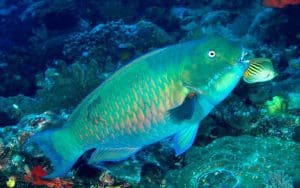
Wrasses (Labridae):
Wrasses are a diverse family of reef-dwelling fish known for their vibrant colors and interesting behaviors. Many wrasses are protogynous hermaphrodites, where they begin as females and later transform into males. This sex change typically occurs in response to environmental or social cues, such as the removal of a dominant male from a group. The newly transformed male then takes over the territorial and reproductive responsibilities.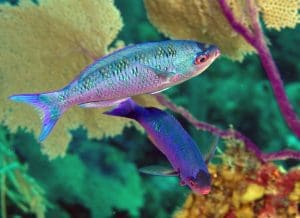
Cleaner Shrimp (Lysmata amboinensis):
Cleaner shrimp, commonly found on coral reefs, are small and highly social crustaceans. They are protandrous hermaphrodites, starting their lives as males and later transitioning to females. In a cleaner shrimp group, the largest individual is the dominant female, while the second-largest becomes the dominant male. This sequential hermaphroditism ensures a stable social structure within their cleaning stations, where they provide cleaning services to other fish by removing parasites and dead skin.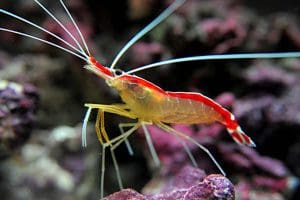
Slipper Shell (Crepidula fornicata):
Slipper shells are marine gastropod mollusks that display simultaneous hermaphroditism. They possess both male and female reproductive organs and can mate with any nearby individual. During mating, two slipper shells will align their bodies in a process known as “stacking,” where one individual functions as a male and the other as a female, resulting in mutual fertilization.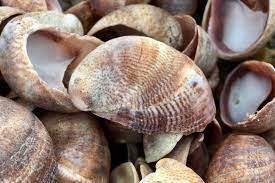
Bluehead Wrasse (Thalassoma bifasciatum):
The bluehead wrasse, commonly found in Caribbean coral reefs, is another example of a protogynous hermaphrodite. In this species, dominant males defend territories and harems of females. When the dominant male is removed, the largest female in the harem undergoes a sex change, transforming into a male and taking over the role of the former dominant male.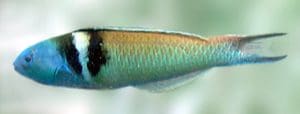
Physical and Hormonal Changes Involved.🐟
When marine animals undergo sex change, a complex series of physical and hormonal transformations occur to facilitate the transition from one sex to another. These changes are critical for successful reproduction and adapting to varying ecological conditions. In this section, we will explore the fascinating world of physical and hormonal changes that take place when these remarkable creatures switch genders.
Physical Changes:
-
- Sequential Hermaphrodites: In species with sequential hermaphroditism, the physical changes are evident as an individual transforms from one sex to another. For example, in protogynous hermaphrodites, such as clownfish and parrotfish, females transform into males. During this transition, the individual’s coloration, size, and even behavioral patterns may change. The new male often exhibits brighter colors and grows larger than the previous female form.
- Simultaneous Hermaphrodites: In species with simultaneous hermaphroditism, such as cleaner shrimp and slipper shells, the physical changes are less apparent as they possess both male and female reproductive organs simultaneously. However, during mating, these organisms exhibit distinct roles as both male and female, enabling mutual fertilization.
Hormonal Changes:
-
- Gonadal Transformation: The transition between sexes in hermaphroditic marine animals involves hormonal regulation of their gonads (reproductive organs). The shift from male to female or vice versa requires a change in hormone production and sensitivity. In protogynous hermaphrodites, when a female changes into a male, there is a decrease in estrogen and an increase in androgen (such as testosterone) levels. These hormonal changes trigger the development of male reproductive structures.
- Reproductive Hormone Regulation: The timing of sex change is often regulated by environmental and social cues. Changes in factors such as population density, availability of mates, or the presence of dominant individuals can influence the release of reproductive hormones, leading to the initiation of sex change in simultaneous hermaphrodites.
Development of Male and Female Reproductive Organs:
-
- Ovaries and Testes: As sequential hermaphrodites transition from one sex to another, their gonads develop accordingly. In protogynous hermaphrodites, ovaries, which produce eggs, transform into testes, responsible for sperm production, when the female changes to a male. In the case of protandrous hermaphrodites, the reverse occurs.
- Simultaneous Hermaphrodites: These organisms have both male and female reproductive organs, which are functional at the same time. During mating, they engage in reciprocal fertilization, where each individual acts as both a male and a female, ensuring successful reproduction for both partners.
The Transition:
-
- Social and Environmental Triggers: The decision to change sex is influenced by various factors, including the availability of mates, social interactions, and environmental conditions. Once the appropriate cues are detected, the hormonal system initiates the physiological changes that lead to sex change.
- Time Frame: The time frame for sex change varies among species. Some marine animals may undergo rapid changes within a few days or weeks, while others may take several months or even years to complete the transition.
Factors Triggering Sex Change.🐟
The ability of marine animals to change their sex is a fascinating and adaptive characteristic that is influenced by a variety of factors. These factors can be broadly categorized into environmental, social, and biological aspects. Understanding the triggers behind sex change provides valuable insights into the complex interplay between an organism’s biology and its surrounding ecosystem. In this section, we will explore the diverse factors that can trigger sex change in these remarkable creatures and highlight the influence of their environment, social interactions, and other biological determinants.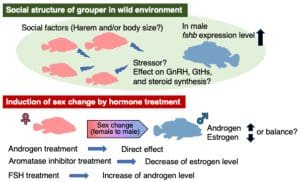
Environmental Factors:
-
- Resource Availability: In environments where resources, such as food or nesting sites, are scarce, sex change can be an advantageous strategy for maximizing an individual’s reproductive potential. Changing sex allows them to exploit new ecological niches and enhance their chances of finding suitable mates.
- Habitat Quality: The quality and stability of a marine animal’s habitat play a significant role in determining whether it will undergo sex change. When environmental conditions deteriorate, or there is a change in the availability of essential resources, sex change may be triggered as a response to these fluctuations.
Social Factors:
-
- Social Hierarchies: In species with social structures, such as dominance hierarchies, the removal or death of a dominant individual can trigger sex change in subordinate individuals. For instance, when a dominant male in a group of protogynous hermaphrodites is eliminated, the largest female may change into a male to take over the vacant position.
- Mate Availability: The availability and distribution of potential mates can significantly influence the decision to change sex. In species with limited access to mates, changing sex may provide an advantage in maximizing reproductive opportunities.
Biological Factors:
-
- Age and Size: Age and size often play a critical role in the decision to undergo sex change. In many sequential hermaphrodites, individuals change sex as they reach a certain age or size threshold. For example, many fish species change sex when they grow large enough to compete for mates effectively.
- Hormonal Regulation: Hormonal signals are vital in regulating sex change. Changes in hormone levels and sensitivities trigger the development of male or female reproductive organs, facilitating the transition from one sex to another.
Social and Environmental Interactions:
-
- Social Cues: Social interactions, such as mating behaviors and competition for mates, can influence an individual’s decision to change sex. The presence of specific social cues or signals may stimulate the physiological changes necessary for sex change to occur.
- Environmental Cues: Environmental cues, such as temperature fluctuations or seasonal changes, can also influence the timing and initiation of sex change in some species.
The Importance for Ecology and Conservation.🐟
The phenomenon of sex change in marine animals holds profound ecological significance, impacting the dynamics of populations and contributing to the resilience of marine ecosystems. Understanding the role of sex change in the lives of these species provides valuable insights into the intricate balance of marine biodiversity. Additionally, this unique adaptation has practical implications for conservation efforts aimed at safeguarding these marine organisms and preserving the delicate ecosystems they inhabit. In this section, we will delve into the importance of sex change for the ecology and conservation of these remarkable marine species.
Role of Sex Change in Ecology:
-
- Maintaining Population Balance: Sex change allows marine species to adjust their sex ratios in response to varying ecological conditions. For instance, in protogynous hermaphrodites, when the population has an excess of females and a scarcity of males, the ability to change sex ensures a more balanced distribution of reproductive individuals within the community.
- Genetic Diversity: By adopting different sexes during their lifetime, these organisms promote genetic diversity within their populations. This diversity enhances the species’ resilience to environmental changes, disease, and other potential threats.
- Facilitating Reproduction: Sex change maximizes an individual’s reproductive opportunities. When an organism becomes a male, it can fertilize the eggs of multiple females, enhancing reproductive success and promoting the survival of the species.
Contribution to Conservation:
-
- Sustainable Fisheries Management: Understanding the sex-changing behavior of certain fish species is vital for sustainable fisheries management. Properly managing the removal of males or females from a population can help maintain stable and healthy fish stocks.
- Ecosystem Function: The presence of hermaphroditic species, particularly those involved in maintaining coral reef ecosystems, like parrotfish, is crucial for the health and resilience of coral reefs. Their grazing activities help control algae growth, ensuring the survival of corals and the diverse marine life they support.
- Indicator Species: Some hermaphroditic marine species are considered indicator species, meaning their presence, abundance, and health can reflect the overall well-being of a particular ecosystem. Monitoring changes in their populations can provide valuable information about the overall health of marine habitats.
Conservation Strategies:
-
- Protected Areas: Identifying and protecting critical habitats where these sex-changing species thrive is essential for their conservation. Establishing marine protected areas can safeguard their habitats and ensure sustainable ecosystems.
- Reducing Human Impacts: Understanding the ecological importance of sex-changing marine species can help drive conservation efforts focused on reducing human impacts, such as overfishing, pollution, and habitat destruction.
- Education and Awareness: Raising awareness about the ecological role of these species can foster public support for their conservation and promote responsible practices in marine environments.


